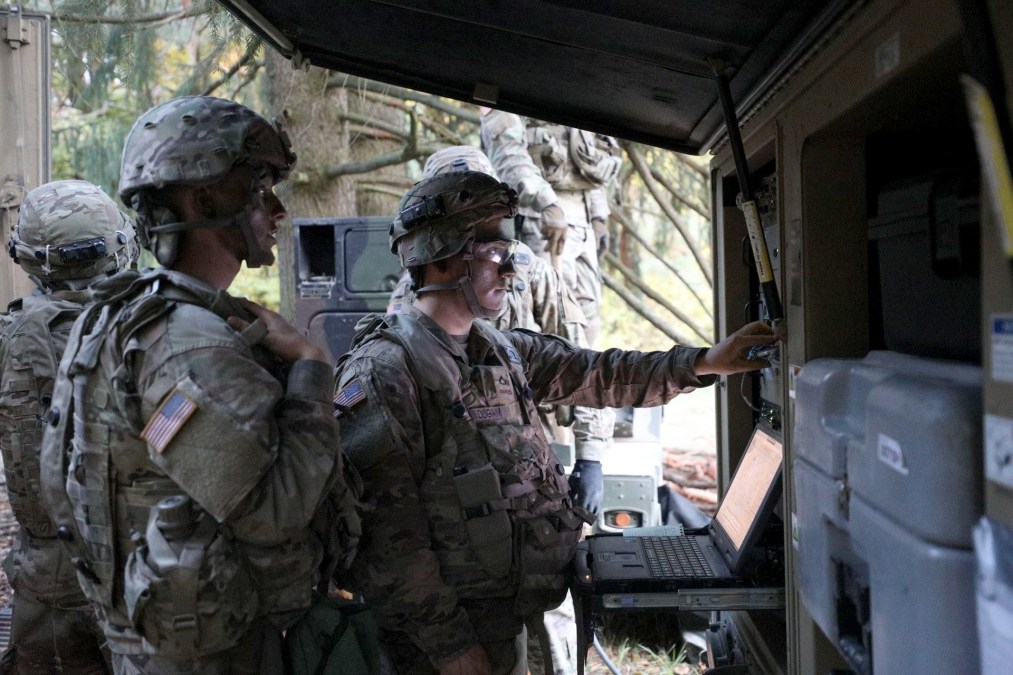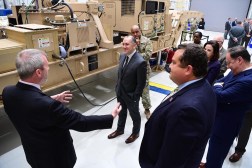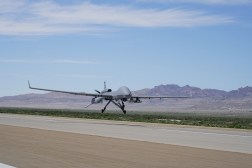Army leaders reviewing network portfolio, looking to place ‘big bets’ on new tech

ABERDEEN PROVING GROUND, Md. — The Army’s undersecretary and vice chief of staff are undertaking a portfolio review while tasking the service’s network modernization team with developing “big bets” for future technology.
The review is aimed at evaluating requirements.
“The vice and I are leading a capability portfolio review of the entire Army network. That’s looking at everything from our requirements for unified network operations, to cybersecurity, to transport — both enterprise and tactical — and looking at cloud adoption and data analytics,” Gabe Camarillo, undersecretary of the Army, told reporters during a visit to Aberdeen Proving Ground, Maryland, Aug. 23 to assess the tactical network portfolio. “We’re looking at it systematically to try to [see] how do we rationalize those requirements, rationalize our investment and spend?”
The Army is undertaking a multi-year effort to deliver a next-generation network, one that unifies its enterprise systems and the systems delivered to tactical environments where troops communicate and transmit battlefield data.
Officials have noted issues in transitioning data and operations from the strategic to tactical networks especially when moving from theater to theater. Some have previously cited issues in which units were not able to join the network immediately upon entering a theater — most recently during the withdrawal operations in Afghanistan — which creates big problems for the Army as it is trying to be more expeditionary.
With a lot of different organizations and pots of money, Camarillo said Army leadership wanted to get their hands around the effort in its entirety.
“If you think about our spend on everything network, from enterprise to tactical, it was in a lot of different organizations. Within the Army, it was in a lot of PEGs, or Program Evaluation Groups, which are the way we segment our [project objective memorandum], our budgets,” Camarillo told reporters Aug. 24 following remarks at the Potomac Officers Club Army Summit. “The idea was to get our arms wrapped around all of it in one place and look at it comprehensively so that we can make sure that we’re making the most effective use of our resources and reprioritizing where needed.”
The review is slated to wrap up this fall.
As the Army’s tactical network team is working to deliver incremental capability advancements to its integrated tactical network through two-year capability sets, Camarillo has charged them with identifying “big bets,” which will also align with the service’s goal of realizing Joint All-Domain Command and Control (JADC2), a top priority for the Pentagon.
“The reason we talked about big bets is in order for the Army to enable JADC2, which is the transport of critical data on the battlefield, which is absolutely critical to the joint force’s success, we have to be able to make the right investments, define the right requirements and to orient our programs to what is going to help us achieve that next-generation level of capability,” Camarillo told reporters.
“I’ve challenged the team here today [about] what can we do in terms of looking at next-generation requirements, big bets, whether it’s in the transport layer, all of our tactical radios, what do we need to do to get at the next generation of evolution? … As we look ahead to the next five years, where do we want to be?” he added.
Officials said these big bets aren’t all about equipment or programs, but processes as well.
“What are those processes that [the undersecretary] can assist us with and potentially getting us across the finish line and moving technology a little faster through the cycle for the … acquisition cycle. [Camarillo] wants to understand what he can help us with when it comes to that,” Brig. Gen. Jeth Rey, director of the Army’s network cross-functional team, told reporters at Aberdeen.
Rey said service leaders asked for a broad set of areas the network team can identify as aim points. The team then identified areas they were working on for the future but used Camarillo’s visit to Aberdeen as a way to assess if everyone was on the same page with these big bets.
These big bets include areas such as virtualization, auto-primary, alternate, contingency and emergency communications, data security, data fabrics and network resiliency, among others.
“From an enabler, looking at things like JADC2 he asked us about transport and bandwidth — are those things that we want to make a big bet on in order to get that particular capability moving from an Army perspective?” Rey said. “He wants us to also look at our data fabric — how does that play into a capability that we can use across all services?”
In fact, the Army has already been able to pull a lot of capability surrounding a data fabric — which is not a single solution, but rather, a federated environment that allows information-sharing among various forces and echelons — forward through experimentation.
“We didn’t really have a tactical data fabric per se in [capability set] 21 but … there was a lot of effort in the S&T community and industry around the data fabric. We took it to [Project Convergence] 21. We got a lot of really good feedback from PC 21 and other events,” Nicholaus Saacks, deputy program executive officer in Program Executive Office Command, Control, Communications-Tactical, told reporters. “We’re getting ready now to field it now as part of Cap Set 23 and the way we’re building it is open enough that come Cap Set 25, if there’s new technologies available or new ways to do it, we can insert those in there.”
The office of the assistant secretary of the Army for acquisition, logistics and technology (ASAALT) is also working on developing a data mesh that will federate the various data fabrics.
“We’re actually making very rapid progress on that data mesh reference architecture. And our intent is to build it [and] give it to industry to give us feedback because we want to make sure that we’re not missing big things, or if we are, we want that feedback to be built into the final version of the reference architecture,” Jennifer Swanson, chief systems engineer in ASAALT, said at the Army Summit.
“We’ve been talking about standards for a long time. We need to now give you what those standards are. And I think that really opens up the playing field for industry because our intent is to allow the industry to plug into that data mesh … We need you to bring your black boxes, but we want to be able to own not just the data, but also all the things that happen to the data over time so that it is really an even playing field and not [have the Army in a position where it’s not] able to compete the next contract because we don’t have all intellectual property that we need with data.”
Rey said the team needs to provide recommendations to top Army leadership about different ways to acquire IT equipment than the current process.
“Is there something that [they] can help with to put that particular technology into the hands of the user a little bit faster?” Rey said. “I think we all come back to [them] on what part of the process needs to be adjusted or something new introduced. I think that’s what we owe them.”
Others said they owe the Army more insights from a threat perspective.
“Part of it is getting to a shared understanding of what’s next from a threat perspective, from an operational concept perspective, from a technology perspective, both where we see commercial technology evolving and that’s particularly applicable within this C5ISR area, but also, where we may have some unique needs that are going to hinder our ability to take advantage of it fully without some modification,” Joseph Welch, director of the C5ISR Center, said. “From an experimentation perspective, where do we see that moving forward in our ability to better understand the warfighting systems we’ll develop before we can deploy them.”






